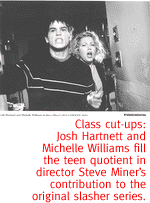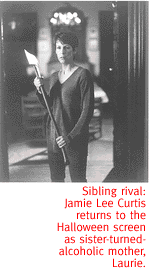

|

'Halloween: H2O' Updates The Slasher Genre With Some New Old Tricks.
By Polly Higgins
BOTH AUDIENCES AND studios have demonstrated a renewed
interest in the horror genre over the past couple of years, and
the most recent evidence is the mid-week release of the slasher
Halloween: H20, directed by Steve Miner.
 The slasher subgenre in particular has been largely relegated
to straight-to-video status since the mid-1980s, but it's gained
new respectability and larger budgets through such successes as
Scream and Scream 2 (which, combined, have grossed
more than $200 million). These two films updated the slasher by
self-consciously referencing the conventions established in the
1970s, most notably in the low-budget Texas Chainsaw Massacre
(1974) and Halloween (1978). H20 offers its
own revisions while following some of the trends of more recent
slasher films. When all is said and done, however, it doesn't
stray too far from its roots.
The slasher subgenre in particular has been largely relegated
to straight-to-video status since the mid-1980s, but it's gained
new respectability and larger budgets through such successes as
Scream and Scream 2 (which, combined, have grossed
more than $200 million). These two films updated the slasher by
self-consciously referencing the conventions established in the
1970s, most notably in the low-budget Texas Chainsaw Massacre
(1974) and Halloween (1978). H20 offers its
own revisions while following some of the trends of more recent
slasher films. When all is said and done, however, it doesn't
stray too far from its roots.
The bulk of the story takes place in the mandatory small town.
Laurie Strode (Jamie Lee Curtis) is presumed dead from a car accident
after the events of Halloween 2, but has actually moved
to California from Illinois and taken on the alias Keri Tate.
She's the headmistress of a private school, where she lives with
Skeet Ulrich stand-in/son John (Josh Hartnett). This setting helps
facilitate the teen storyline, another genre convention (though
notably, this is but a subplot). While John and friends are giggling
about sex and stealing booze, the main narrative follows Laurie,
who's in her late 30s.
 The majority of slasher films are concerned with the fates of
teenage girls, so this particular element of H20 illustrates
the major reason why the genre has recently been successful: The
widening of the target audience. Typical slasher movies very specifically
address adolescent males, and this usually results in lots of
teenage T&A. More recent productions attempt to broaden that
audience base to include female viewers, and H20 in particular
strives not only for a coed teenage audience, but an adult one
as well. Sorry to disappoint, but you'll have to rent Slumber
Party Massacre if you want skin.
The majority of slasher films are concerned with the fates of
teenage girls, so this particular element of H20 illustrates
the major reason why the genre has recently been successful: The
widening of the target audience. Typical slasher movies very specifically
address adolescent males, and this usually results in lots of
teenage T&A. More recent productions attempt to broaden that
audience base to include female viewers, and H20 in particular
strives not only for a coed teenage audience, but an adult one
as well. Sorry to disappoint, but you'll have to rent Slumber
Party Massacre if you want skin.
Or you could rent the first Halloween, though Curtis remains
clothed there as well. In that film she's innocent and sexually
repressed, important qualifications for survival. Twenty years
later she's not so sheltered, however. She's lost the feathered
hair and shyness and gained a prescription drug and alcohol habit.
So when Michael "pure evil" Myers (Chris Durand) comes
for a visit, you don't get the usual sense of darkness invading
an idyllic place that you do in the initial installment. Laurie's
world is already scary--she has visions of her temperamental brother
both while she's asleep and awake. This provides some satisfyingly
creepy moments, as Laurie can't always discern whether Michael
is physically present.
And, antisocial tendencies aside, Michael is one of the most
likable features of the Halloween series. There's nothing
scarier than the wrath of a child in a horror film; and Michael,
despite his savvy behind the wheel of a car, is in many ways still
the young boy who killed his other sister in 1963. He seems genuinely
confused at times, particularly when he tilts his head to one
side like a puppy. But have no sympathy--this puppy has teeth.
Plus, despite the fact that he's one of the slowest-moving monsters
around, he always manages to catch up.
 Given the large number of gun-obsessed movies of recent years,
it's comforting to see a killer who still prefers the classic
knife. Michael always did have a soft spot for cutlery, and that's
not the only instance of adherence to the original film.
Given the large number of gun-obsessed movies of recent years,
it's comforting to see a killer who still prefers the classic
knife. Michael always did have a soft spot for cutlery, and that's
not the only instance of adherence to the original film.
Other, more resonant parallels occur, such as Laurie's protection
of her son and his girlfriend. This mimics her selfless concern
for the boy and girl she baby-sits in Halloween. Also,
the methodical Michael plans his return when John is 17, the same
age Laurie was when Michael first visited her. Such narrative
details deflect attention from the lack of cohesiveness of the
seven-film series as a whole, such as Laurie's failure to mention
her daughter, who drives the plots of Halloween IV and
V.
One of the most obvious changes from the original is the budget,
and, with a bigger price tag comes name-brand actors. Besides
Curtis, the cast includes LL Cool J as a security guard, and Janet
Leigh as Laurie's secretary. Both provide comic relief: Ronny
recites his self-penned erotic fiction, and Norma stands next
to the car Leigh's better-known secretary drove in Psycho as
she tells the tense Laurie, "We've all had bad things happen
to us."
Another subtle reference to a classic horror film includes a
reenactment of the knife-throwing scene from Carrie,
played out, not surprisingly, by Keri (Laurie) as she tries
to fend off Michael.
But the creators of H20 (none of whom, notably, is John
Carpenter) demonstrate their debt to the more recent seminal slasher
series through the use of a clip from Scream 2. This consciousness
of the need to update the genre, to make it relevant and sellable
to new audiences, may enable horror to retain its newly appointed
status of respectability beyond a few select films.

|
 |





